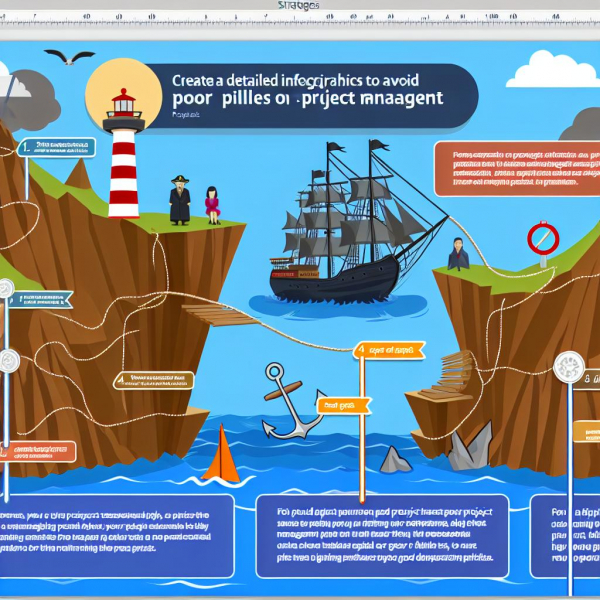In the grand theatre of the digital age, businesses are the eager actors, ready to don the costume of digital transformation. They are poised to recite the lines of innovation, efficiency, and growth. But, like any theatrical performance, the play of digital transformation is fraught with potential missteps and pitfalls. It’s a script that can easily turn from a triumphant soliloquy to a tragic monologue. As we pull back the curtain on this digital drama, let’s explore the three critical blunders that can turn your digital transformation from a standing ovation into a stage disaster.
Table of Contents
- Ignoring the Importance of a Digital Culture
- The Pitfalls of Neglecting Employee Training
- The Dangers of Inadequate Infrastructure Investment
- How to Avoid the Downfall of Poor Project Management
- The Role of Leadership in Successful Digital Transformation
- The Consequences of Not Adapting to Market Changes
- Turning Digital Transformation Failures into Success Stories
- Q&A
- In Summary

Ignoring the Importance of a Digital Culture
One of the most overlooked aspects of digital transformation is the creation and nurturing of a digital culture within an organization. Many businesses focus solely on the technical aspects of the transformation, such as implementing new software or upgrading hardware. However, without a strong digital culture, these efforts can be in vain. A digital culture encourages employees to embrace new technologies, fosters innovation, and promotes a more efficient and collaborative work environment.
When an organization fails to establish a digital culture, it can lead to several issues. Resistance to change is one of the most common problems. Employees who are not comfortable with technology or who do not understand its benefits can resist the changes, slowing down the transformation process. Lack of collaboration is another issue. Without a digital culture, employees may not use digital tools to their full potential, leading to inefficiencies and missed opportunities. Finally, a lack of digital culture can lead to a lack of innovation. When employees are not encouraged to experiment with new technologies, the organization can miss out on new ideas and solutions.
| Issue | Consequence |
|---|---|
| Resistance to change | Slows down the transformation process |
| Lack of collaboration | Leads to inefficiencies and missed opportunities |
| Lack of innovation | Organization misses out on new ideas and solutions |
Therefore, it is crucial for organizations to not only focus on the technical aspects of digital transformation but also on creating a strong digital culture. This includes training employees on new technologies, promoting collaboration through digital tools, and encouraging innovation and experimentation.

The Pitfalls of Neglecting Employee Training
One of the most overlooked aspects of digital transformation is the importance of employee training. Many organizations make the mistake of focusing solely on the technological aspects, forgetting that their employees are the ones who will be using these new systems and tools. Without proper training, employees can feel overwhelmed and frustrated, leading to decreased productivity and morale.
There are several ways that neglecting employee training can derail your digital transformation. Firstly, it can lead to inefficient use of new technologies. Without understanding how to use them properly, employees may not be able to take full advantage of the benefits these technologies offer. Secondly, it can result in increased errors. Untrained employees are more likely to make mistakes, which can lead to costly delays and rework. Lastly, it can cause resistance to change. Employees who are not given the support they need to adapt to new technologies may resist the change, slowing down the transformation process.
| Pitfall | Consequence |
|---|---|
| Inefficient use of new technologies | Unable to fully utilize the benefits of the new system |
| Increased errors | Costly delays and rework |
| Resistance to change | Slows down the transformation process |
Therefore, it’s crucial to invest in comprehensive training programs that not only teach employees how to use new technologies, but also help them understand the reasons behind the change and the benefits it will bring. This will ensure a smoother transition and increase the chances of your digital transformation being a success.

The Dangers of Inadequate Infrastructure Investment
When it comes to digital transformation, one of the most overlooked aspects is the investment in infrastructure. Many businesses are so focused on the shiny new software and applications that they forget about the backbone that supports it all. Without adequate infrastructure investment, your digital transformation could be doomed before it even begins.
Firstly, poor performance is a major risk. Without the right infrastructure, your new digital systems may run slowly or not at all. This can lead to frustration among employees and customers, and ultimately, a loss of business. Secondly, security vulnerabilities can be exposed. If your infrastructure isn’t robust enough, it could be easy for hackers to gain access to your systems and data. Lastly, scalability issues can arise. If your business grows or your needs change, your infrastructure may not be able to keep up.
- Poor performance: Slow or non-functioning systems can lead to business loss.
- Security vulnerabilities: Weak infrastructure can expose your systems and data to hackers.
- Scalability issues: Your infrastructure may not be able to adapt to business growth or changing needs.
| Issue | Impact |
|---|---|
| Poor performance | Loss of business due to slow or non-functioning systems |
| Security vulnerabilities | Exposure of systems and data to hackers |
| Scalability issues | Inability to adapt to business growth or changing needs |

How to Avoid the Downfall of Poor Project Management
When it comes to digital transformation, the stakes are high. A poorly managed project can lead to wasted resources, missed opportunities, and a negative impact on your business’s reputation. To avoid these pitfalls, it’s crucial to be aware of the common mistakes that can derail your digital transformation journey.
1. Lack of Clear Goals and Objectives
Without a clear vision and well-defined objectives, your digital transformation project is like a ship without a compass. It’s essential to establish what you want to achieve, how you plan to do it, and what success looks like. This will provide direction and focus for your team, and help to ensure that everyone is working towards the same end goal.
2. Inadequate Communication
Communication is key in any project, but it’s particularly important in digital transformation. Your team needs to understand the project’s objectives, their individual roles and responsibilities, and how their work contributes to the overall goal. Regular updates and feedback are also crucial to keep everyone on track and address any issues or concerns as they arise.
3. Ignoring User Experience
Digital transformation isn’t just about implementing new technologies - it’s about improving the user experience. If you don’t take the time to understand your users’ needs and expectations, your project is likely to fall flat. User feedback and testing should be integral parts of your project, helping to ensure that the end result meets your users’ needs and delivers real value.
| Common Mistakes | Solutions |
|---|---|
| Lack of clear goals and objectives | Establish a clear vision and well-defined objectives |
| Inadequate communication | Ensure regular updates and feedback |
| Ignoring user experience | Integrate user feedback and testing |
By avoiding these common mistakes, you can help to ensure that your digital transformation project is a success. Remember, digital transformation is a journey, not a destination - so it’s important to continually learn, adapt, and improve along the way.
The Role of Leadership in Successful Digital Transformation
Digital transformation is a complex process that requires a strategic approach and strong leadership. However, there are certain pitfalls that can derail your digital transformation journey. Here are three common mistakes that can ruin your digital transformation.
1. Lack of Clear Vision and Strategy: Without a clear vision and strategy, your digital transformation efforts can quickly become chaotic and uncoordinated. It’s essential to have a clear understanding of what you want to achieve and how you plan to get there. This includes setting clear goals, defining key performance indicators (KPIs), and developing a roadmap for implementation.
2. Resistance to Change: Change can be difficult, and resistance to change is one of the biggest obstacles to successful digital transformation. It’s important to communicate the benefits of digital transformation to all stakeholders, and to provide training and support to help people adapt to new ways of working.
3. Neglecting Customer Experience: Digital transformation should not be just about technology. It should also be about improving the customer experience. If you neglect the customer experience in your digital transformation efforts, you risk alienating your customers and damaging your brand.
| Common Mistakes | How to Avoid |
|---|---|
| Lack of Clear Vision and Strategy | Set clear goals, define KPIs, develop a roadmap |
| Resistance to Change | Communicate benefits, provide training and support |
| Neglecting Customer Experience | Focus on improving the customer experience |
In conclusion, successful digital transformation requires strong leadership, a clear vision and strategy, a willingness to embrace change, and a focus on improving the customer experience. By avoiding these common mistakes, you can increase your chances of success in your digital transformation journey.
The Consequences of Not Adapting to Market Changes
When it comes to digital transformation, one of the biggest pitfalls is failing to adapt to market changes. This can have severe consequences, leading to a loss of competitive advantage, decreased customer satisfaction, and even business failure.
Loss of Competitive Advantage: In today’s fast-paced digital world, staying ahead of the competition is crucial. If you fail to adapt to market changes, your competitors will likely seize the opportunity to innovate and gain a competitive edge. They may introduce new technologies, improve their services, or change their business models to better meet customer needs. This can leave your business lagging behind, struggling to catch up.
- Decreased Customer Satisfaction: Customers today expect businesses to be responsive and adaptable. If your business fails to keep up with market changes, it can lead to decreased customer satisfaction. Customers may feel that your business is out of touch or not meeting their needs, leading them to seek out competitors who are more in tune with the current market trends.
- Business Failure: In the worst-case scenario, failing to adapt to market changes can lead to business failure. If your business is unable to keep up with the pace of change, it may struggle to stay afloat. This is particularly true in industries that are rapidly evolving, where businesses that fail to adapt can quickly become obsolete.
| Consequence | Impact |
|---|---|
| Loss of Competitive Advantage | Struggling to keep up with competitors |
| Decreased Customer Satisfaction | Loss of customer loyalty and potential revenue |
| Business Failure | Business closure or bankruptcy |
Adapting to market changes is not just about survival, but also about seizing opportunities for growth and innovation. By staying agile and responsive, your business can not only weather market changes, but also thrive in the digital age.
Turning Digital Transformation Failures into Success Stories
Embarking on a digital transformation journey is no small feat. It requires a significant investment of time, resources, and effort. However, despite the best intentions and meticulous planning, some digital transformations fail. But, these failures can be turned into success stories if you know what pitfalls to avoid. Here are three common mistakes that can ruin your digital transformation.
1. Lack of Clear Vision and Strategy: A digital transformation is not just about implementing new technologies. It’s about reimagining your business in the digital age. Without a clear vision and strategy, your digital transformation efforts can become disjointed and ineffective. It’s crucial to define what digital transformation means for your business, set clear goals, and develop a comprehensive strategy to achieve them.
2. Resistance to Change: Change can be difficult, and digital transformation involves significant changes. Employees may resist these changes due to fear of the unknown or concern about job security. It’s essential to communicate the benefits of digital transformation clearly and provide training and support to help employees adapt to new technologies and processes.
3. Neglecting Customer Experience: Digital transformation should enhance the customer experience, not detract from it. However, some businesses become so focused on implementing new technologies that they neglect the impact on their customers. Always keep the customer at the center of your digital transformation efforts.
| Mistake | Solution |
|---|---|
| Lack of Clear Vision and Strategy | Define what digital transformation means for your business, set clear goals, and develop a comprehensive strategy. |
| Resistance to Change | Communicate the benefits of digital transformation clearly and provide training and support to help employees adapt. |
| Neglecting Customer Experience | Always keep the customer at the center of your digital transformation efforts. |
By avoiding these common mistakes, you can turn your digital transformation failures into success stories. Remember, digital transformation is a journey, not a destination. It requires continuous learning, adaptation, and improvement. So, keep moving forward, learn from your mistakes, and turn your failures into stepping stones to success.
Q&A
Q: What is digital transformation?
A: Digital transformation is the process of integrating digital technology into all areas of a business, fundamentally changing how you operate and deliver value to customers. It’s also a cultural change that requires organizations to continually challenge the status quo, experiment, and get comfortable with failure.
Q: What are the three ways that can ruin my digital transformation?
A: The three ways that can ruin your digital transformation are lack of a clear strategy, resistance to change, and inadequate investment in training and development.
Q: Can you elaborate on the importance of a clear strategy in digital transformation?
A: Absolutely. A clear strategy is the roadmap for your digital transformation. It outlines your goals, the steps you need to take to achieve them, and the metrics you will use to measure success. Without a clear strategy, your digital transformation efforts can become unfocused and ineffective.
Q: How does resistance to change affect digital transformation?
A: Resistance to change can be a major roadblock in digital transformation. Employees may be comfortable with current processes and systems and may resist the changes brought about by digital transformation. This can slow down the transformation process and even lead to its failure.
Q: Why is investment in training and development crucial for digital transformation?
A: Digital transformation often involves the use of new technologies and processes. Without adequate training and development, employees may struggle to adapt to these changes, leading to decreased productivity and morale. Investment in training and development ensures that your team has the skills and knowledge they need to effectively implement and use new digital tools and processes.
Q: Can these pitfalls be avoided?
A: Yes, these pitfalls can be avoided with careful planning and execution. It’s important to communicate your digital transformation strategy clearly to all stakeholders, address resistance to change proactively, and invest in training and development to equip your team with the necessary skills and knowledge.
Q: What are the benefits of a successful digital transformation?
A: A successful digital transformation can lead to increased efficiency, improved customer experience, and a competitive advantage in the market. It can also foster a culture of innovation and agility within your organization.
In Summary
In the digital landscape, the path to transformation is not always paved with gold. It’s often strewn with pitfalls and obstacles that can derail your journey. But remember, the key to successful digital transformation lies not in avoiding these pitfalls, but in recognizing and navigating them effectively. As we’ve explored, a lack of clear vision, resistance to change, and inadequate data management can all spell disaster for your digital transformation. But with careful planning, a flexible mindset, and a robust data strategy, you can turn these potential pitfalls into stepping stones towards a successful digital future. So, venture forth into the digital realm with caution, but also with optimism. After all, every challenge is an opportunity in disguise.
